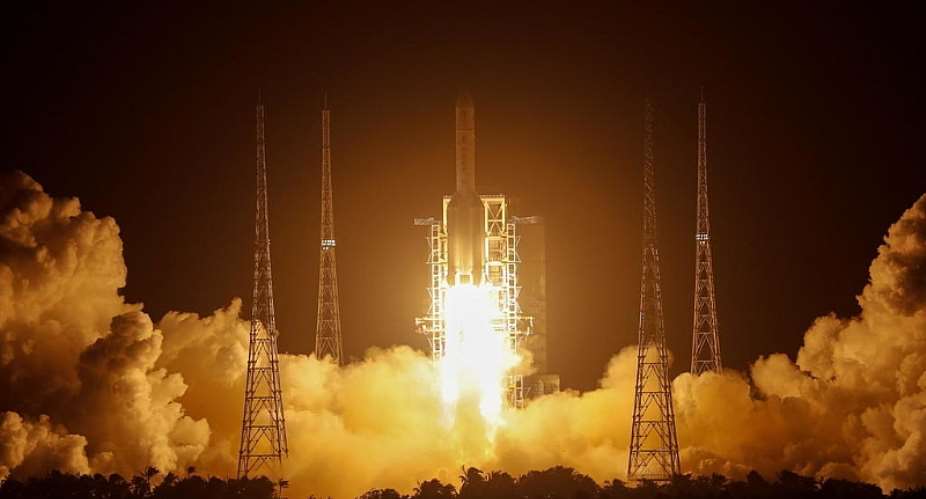China launched its latest and to date, one of its most ambitious space missions called Chang'e 5 that will attempt to retrieve lunar rock samples, which, if it succeeds will be a first in 44 years. If it succeeds, China will become only the third country after the United States and the Soviet Union to have brought back samples from the Moon to the Earth.
“Chang'e 5 will collect samples from a different region of the Moon which makes it very valuable,” Frédéric Moynier of the Institut de Physique du Globe de Paris told RFI.
Moynier, who is an expert on lunar and Martian rocks samples said that while the scientific community learned a lot about the Moon from the samples brought back by the Apollo and the Luna missions, there were some limitations.
“There were a limited number of samples and all of them came from a small region of the Moon that has many craters.
The Chinese mission will collect samples from a region with less craters. This could mean that there might have been an event such as a magmatic eruption that covered the older craters and created a younger, fresh surface,” he said.
The Chang'e probe will collect two kilograms of the lunar surface material and bring it back to the Earth around mid-December.
Moynier reckons that besides its scientific value the mission will also be a demonstrator for more ambitious projects such as collecting samples from the far side of the Moon and a mission to Mars.
The Chang'e 5 is the latest in a series of recent missions to the Moon over the past 15 years by different countries including China, the US, India and Israel.
One of the reasons behind the renewed interest is linked to the discovery of water. “Based on the findings of the Apollo and Luna missions, we thought the Moon surface was dry. When the US won the political competition with the Soviets, there no longer remained a push to go back to the moon.”
“However, over the past few years we discovered that there is water on the moon which has triggered a new interest among the scientific community,” Moynier said.
The presence of water also means the Moon could become a valuable factor in the future space missions. “It's an important stop for space exploration. That's because due to its low gravity, it will be much easier to launch missions from the Moon than the Earth,” Moynier said.
The other interesting aspect about the moon is the presence of rare earth minerals and helium on its surface. Unlike earth, where solar winds don't reach the surface duke to the magnetic shield and the atmosphere, the moon has no such protection. Since its formation, the solar wind has been hitting the lunar surface and in the process generating helium 3.
“Helium 3 is interesting because of its potential use in fusion. One way to do it is to combine hydrogen and helium 3 to produce helium 4. We don't have the technology yet but if one day we do develop it, there is no helium 3 on the Earth while the Moon has it,” Moynier said.





 It’s an abuse of power to arrest ECG officials for performing legitimate duties ...
It’s an abuse of power to arrest ECG officials for performing legitimate duties ...
 Unreasonable Actions of GTEC to Collapse Private Universities, Colleges, Institu...
Unreasonable Actions of GTEC to Collapse Private Universities, Colleges, Institu...
 Corruption makes a lot of people rich, happy; NDC, NPP cannot help us – Okyeame ...
Corruption makes a lot of people rich, happy; NDC, NPP cannot help us – Okyeame ...
 GOIL increases fuel prices again, diesel sells GHC14.80, GHC14.99 per litre of p...
GOIL increases fuel prices again, diesel sells GHC14.80, GHC14.99 per litre of p...
 Bawumia will use Ghana’s gold to stabilize the Cedi if voted as President — Ahia...
Bawumia will use Ghana’s gold to stabilize the Cedi if voted as President — Ahia...
 Arrival of state-of-the-art bullet trains signify Ghana’s journey towards enhanc...
Arrival of state-of-the-art bullet trains signify Ghana’s journey towards enhanc...
 Idea behind Performance Tracker is great but shouldn't be limited to election ye...
Idea behind Performance Tracker is great but shouldn't be limited to election ye...
 Election 2024: Bawumia losing 21.8% of NPP’s 2020 Akan votes — Global InfoAnalyt...
Election 2024: Bawumia losing 21.8% of NPP’s 2020 Akan votes — Global InfoAnalyt...
 People are celebrating their 80th birthday and Ghana owes GHS650 billion; who is...
People are celebrating their 80th birthday and Ghana owes GHS650 billion; who is...
 Court issues arrest warrant for Chinese Iron woman, one other over cantonments l...
Court issues arrest warrant for Chinese Iron woman, one other over cantonments l...
